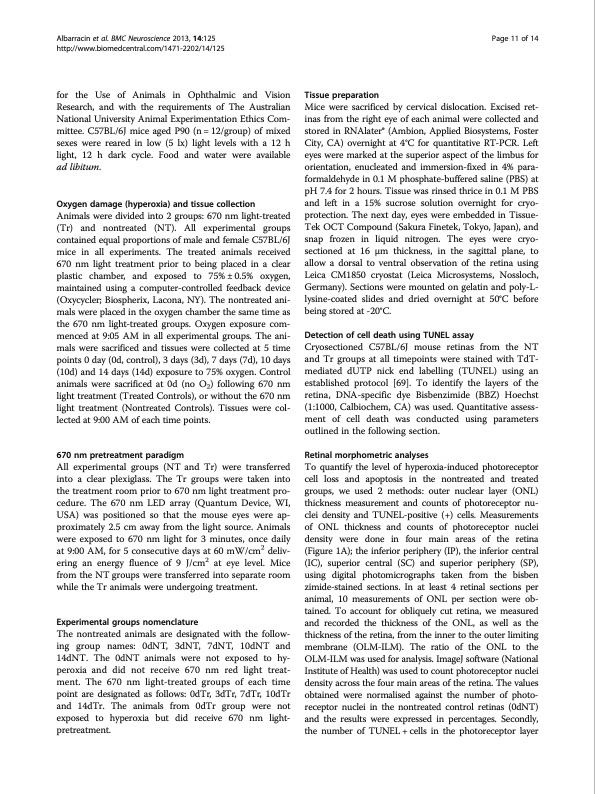
PDF Publication Title:
Text from PDF Page: 011
Albarracin et al. BMC Neuroscience 2013, 14:125 http://www.biomedcentral.com/1471-2202/14/125 for the Use of Animals in Ophthalmic and Vision Research, and with the requirements of The Australian National University Animal Experimentation Ethics Com- mittee. C57BL/6J mice aged P90 (n = 12/group) of mixed sexes were reared in low (5 lx) light levels with a 12 h light, 12 h dark cycle. Food and water were available ad libitum. Oxygen damage (hyperoxia) and tissue collection Animals were divided into 2 groups: 670 nm light-treated (Tr) and nontreated (NT). All experimental groups contained equal proportions of male and female C57BL/6J mice in all experiments. The treated animals received 670 nm light treatment prior to being placed in a clear plastic chamber, and exposed to 75% ± 0.5% oxygen, maintained using a computer-controlled feedback device (Oxycycler; Biospherix, Lacona, NY). The nontreated ani- mals were placed in the oxygen chamber the same time as the 670 nm light-treated groups. Oxygen exposure com- menced at 9:05 AM in all experimental groups. The ani- mals were sacrificed and tissues were collected at 5 time points 0 day (0d, control), 3 days (3d), 7 days (7d), 10 days (10d) and 14 days (14d) exposure to 75% oxygen. Control animals were sacrificed at 0d (no O2) following 670 nm light treatment (Treated Controls), or without the 670 nm light treatment (Nontreated Controls). Tissues were col- lected at 9:00 AM of each time points. 670 nm pretreatment paradigm All experimental groups (NT and Tr) were transferred into a clear plexiglass. The Tr groups were taken into the treatment room prior to 670 nm light treatment pro- cedure. The 670 nm LED array (Quantum Device, WI, USA) was positioned so that the mouse eyes were ap- proximately 2.5 cm away from the light source. Animals were exposed to 670 nm light for 3 minutes, once daily at 9:00 AM, for 5 consecutive days at 60 mW/cm2 deliv- ering an energy fluence of 9 J/cm2 at eye level. Mice from the NT groups were transferred into separate room while the Tr animals were undergoing treatment. Experimental groups nomenclature The nontreated animals are designated with the follow- ing group names: 0dNT, 3dNT, 7dNT, 10dNT and 14dNT. The 0dNT animals were not exposed to hy- peroxia and did not receive 670 nm red light treat- ment. The 670 nm light-treated groups of each time point are designated as follows: 0dTr, 3dTr, 7dTr, 10dTr and 14dTr. The animals from 0dTr group were not exposed to hyperoxia but did receive 670 nm light- pretreatment. Page 11 of 14 Tissuepreparation Mice were sacrificed by cervical dislocation. Excised ret- inas from the right eye of each animal were collected and stored in RNAlater® (Ambion, Applied Biosystems, Foster City, CA) overnight at 4°C for quantitative RT-PCR. Left eyes were marked at the superior aspect of the limbus for orientation, enucleated and immersion-fixed in 4% para- formaldehyde in 0.1 M phosphate-buffered saline (PBS) at pH 7.4 for 2 hours. Tissue was rinsed thrice in 0.1 M PBS and left in a 15% sucrose solution overnight for cryo- protection. The next day, eyes were embedded in Tissue- Tek OCT Compound (Sakura Finetek, Tokyo, Japan), and snap frozen in liquid nitrogen. The eyes were cryo- sectioned at 16 μm thickness, in the sagittal plane, to allow a dorsal to ventral observation of the retina using Leica CM1850 cryostat (Leica Microsystems, Nossloch, Germany). Sections were mounted on gelatin and poly-L- lysine-coated slides and dried overnight at 50°C before being stored at -20°C. Detection of cell death using TUNEL assay Cryosectioned C57BL/6J mouse retinas from the NT and Tr groups at all timepoints were stained with TdT- mediated dUTP nick end labelling (TUNEL) using an established protocol [69]. To identify the layers of the retina, DNA-specific dye Bisbenzimide (BBZ) Hoechst (1:1000, Calbiochem, CA) was used. Quantitative assess- ment of cell death was conducted using parameters outlined in the following section. Retinal morphometric analyses To quantify the level of hyperoxia-induced photoreceptor cell loss and apoptosis in the nontreated and treated groups, we used 2 methods: outer nuclear layer (ONL) thickness measurement and counts of photoreceptor nu- clei density and TUNEL-positive (+) cells. Measurements of ONL thickness and counts of photoreceptor nuclei density were done in four main areas of the retina (Figure 1A); the inferior periphery (IP), the inferior central (IC), superior central (SC) and superior periphery (SP), using digital photomicrographs taken from the bisben zimide-stained sections. In at least 4 retinal sections per animal, 10 measurements of ONL per section were ob- tained. To account for obliquely cut retina, we measured and recorded the thickness of the ONL, as well as the thickness of the retina, from the inner to the outer limiting membrane (OLM-ILM). The ratio of the ONL to the OLM-ILM was used for analysis. ImageJ software (National Institute of Health) was used to count photoreceptor nuclei density across the four main areas of the retina. The values obtained were normalised against the number of photo- receptor nuclei in the nontreated control retinas (0dNT) and the results were expressed in percentages. Secondly, the number of TUNEL + cells in the photoreceptor layerPDF Image | 670 nm light mitigates oxygen-induced degeneration 2013

PDF Search Title:
670 nm light mitigates oxygen-induced degeneration 2013Original File Name Searched:
670nm-light-mitigates-oxygen-induced-degeneration-in-mouse-retina.pdfDIY PDF Search: Google It | Yahoo | Bing
Cruise Ship Reviews | Luxury Resort | Jet | Yacht | and Travel Tech More Info
Cruising Review Topics and Articles More Info
Software based on Filemaker for the travel industry More Info
The Burgenstock Resort: Reviews on CruisingReview website... More Info
Resort Reviews: World Class resorts... More Info
The Riffelalp Resort: Reviews on CruisingReview website... More Info
| CONTACT TEL: 608-238-6001 Email: greg@cruisingreview.com | RSS | AMP |